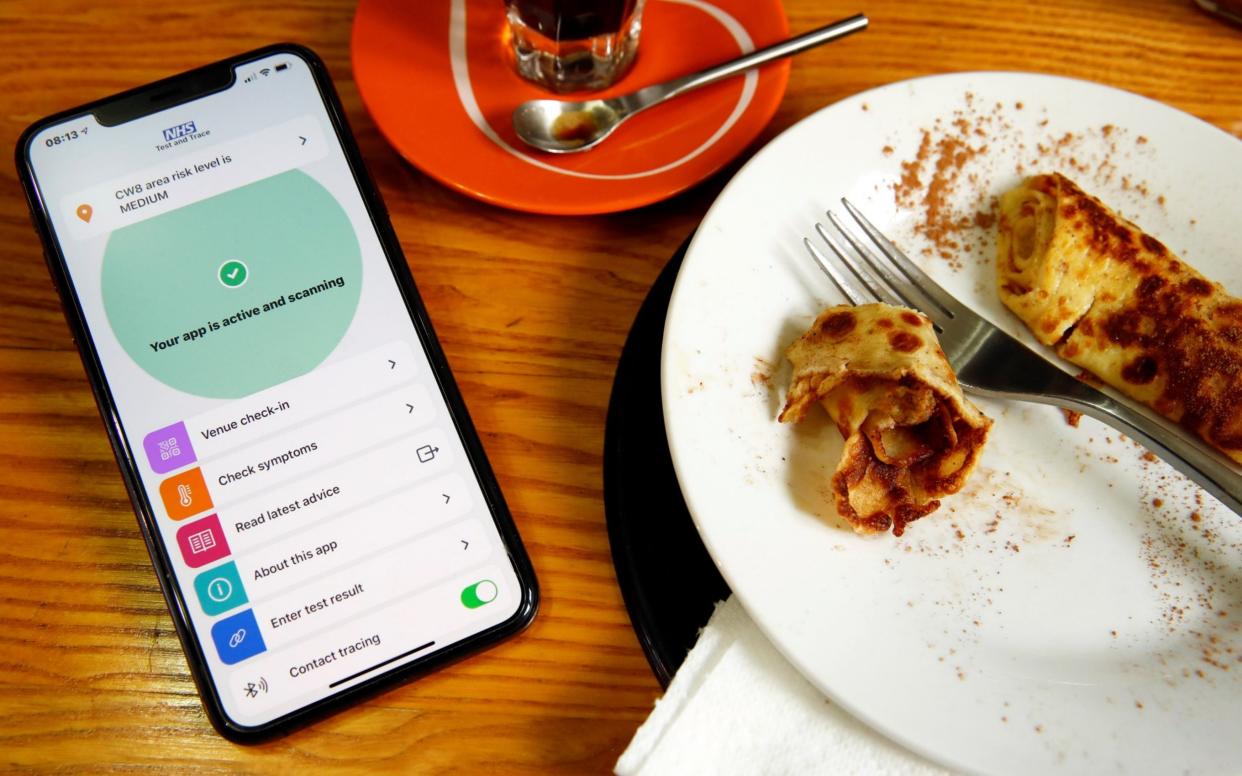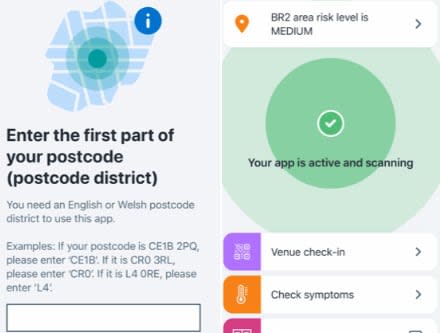NHS Covid-19 app: how will track and trace work?

After months of delays and millions of pounds, on Thursday the NHS belatedly launched its official contact tracing in England and Wales.
The so-called NHS Covid-19 app will ask users who have been near someone with a positive coronavirus test result to self-isolate for two weeks.
It will also allow users to check-in to pubs, restaurants or other venues by scanning a QR code on their phone. They will then get an alert telling them to self-isolated if other visitors at the same time are found to have been infected.
For many, however, confusion persists about how exactly the app works. Here's everything you need to know about how to get set up and use the NHS Covid-19 app:
How do I download the NHS Covid-19 app?
To download the app, visit the App Store on your iPhone, or the Google Play Store on your Android phone. The app is only available on phones, and can't be used on smartwatches or tablets.
Open the search screen and type in “NHS Covid-19.” Then download the app on to your phone.
The app will only work with recent smartphone operating software. So you’ll need to have iOS 13.5 or later installed on your iPhone or Android 6.0 or later installed on your Android phone.
To update the operating system on your iPhone plug your device into power and connect to the internet using Wi-Fi. Then go to Setting, General, then tap Software Update.
To update on an Android phone, first make sure your device is connected to Wi-Fi. Open Settings, then select About Phone. You can then select Check for Updates. If an update is available, an Update button will appear, allowing you to install the latest system.
Some older devices, such as the iPhone 6 and older iPhones, won’t be able to run the app. Some of the latest Huawei handsets will also be unable to use the app.
The new #NHSCOVID19app, now available in England and Wales, is the fastest way of knowing when you’re at risk from coronavirus.
Download now from:
➡️Google Play Store: https://t.co/VHeUifthBs
➡️Apple App Store: https://t.co/bs8z1pCUhZ
Find out more: https://t.co/rzgGGmuV13 pic.twitter.com/srtzSJOgwH— NHS COVID-19 app (@NHSCOVID19app) September 23, 2020
How do I activate the app?
Once you have downloaded the app, you will be presented with a Privacy Notice. Read through it to know how your data will be used, and click Agree if you wish to continue using the app.
You will then be asked to enter the first part of your postcode, as shown in the image below. Once you've done this, an alert will appear asking you to enable Covid-19 exposure logging and notifications. This will allow the app to notify you if you've been exposed to someone who has coronavirus.

Another alert will then pop up asking if the app can send notifications to your phone. Once you have enabled this, the app will be ready to use.
How does the app work?
The app is powered by an Apple and Google-developed system, using Bluetooth to keep an anonymous log of close contacts: those which have come within two metres for 15 minutes.
If two people who are using the app are in close contact to one another for more than five minutes, they will exchange keys, or Bluetooth "digital handshakes". The Bluetooth signal strength is used to measure proximity.
The data logged through these interactions is used to build up a points score of how many times and how long someone has interacted with another person over the course of a day.
If someone tests positive for coronavirus, they can tell the app, which will then ping their keys to a central server and in turn find out who has been in contact with that individual.
Should the system determine a person as a close contact, they will be automatically sent a notification asking them to self-isolate for two weeks. The recipient of the alert is not told who triggered the notification.
Anyone who receives an alert, even if they don't have symptoms or later receive a negative test result, must self-isolate for 14 days.
What other features are available?
A QR code scanning feature is available, allowing people to check in to venues they visit and share their contact details for human tracing efforts.
Some 160,000 businesses have already downloaded QR codes for use in their facilities.
The app also has a function that enables users to book a test, a local risk-level alert tool, a symptoms-reporter tool and a countdown timer to keep track of how long to stay in self-isolation.
The app is available to people aged 16 and upwards, and currently available in eight languages.
Will the app drain my battery?
Because the app requires Bluetooth running in the background to scan for potential exposures to people with coronavirus, there have been some concerns that leaving the app running in the background could drain smartphone batteries.
But the app is likely to only drain 5pc or less of your battery life, meaning you shouldn’t see a dramatic reduction in how long you can use your phone for.
How will the NHS Covid-19 app use QR codes?
You’ll start to see official NHS posters featuring a QR code in venues across the UK. These codes can be scanned using the NHS app to let it know where you were and at what time, helping to track who may have come in contact with someone with a positive diagnosis.
It does this by adding the venue to the app's "digital diary". In England, the user will not need to give their personal details to the venue.
To scan a venue’s QR code, open the NHS app and tap the “Venue check-in” button on the main menu once the app is fully set up and functioning.
Point the app’s camera screen at the QR code and wait for confirmation that it has been scanned successfully.
You don’t need to do anything else - this means the app has registered where you are.
If other people were at the same venue at the same time as you, and later test positive for coronavirus, you will get an alert to let you know.
Businesses and venues can now get ready for the national launch of the #NHSCOVID19app on 24 Sept by downloading NHS QR Posters. Making it easier for your customers to safely check-in and be alerted in the event of a coronavirus outbreak.
Find out more: https://t.co/Tha5y91tcO pic.twitter.com/ph29HS8FSi— NHS COVID-19 app (@NHSCOVID19app) September 15, 2020
What does my postcode district risk level mean?
You provide the first half of your postcode to the app so the government can notify you when your area’s risk level changes. Here's what each risk level means
High
High risk level means your local authority is using additional measures, such as lockdown, to reduce transmission.
Medium
If your area is at medium risk then your local authority, or a neighbouring local authority, has higher levels of infection than other parts of the country. A local area plan has likely been put in place to reduce infection, such as additional testing in care homes and added mobile testing capacity.
Low
In low-risk areas, normal coronavirus control measures are in place.
How will the app help me book a test?
You can report details of your symptoms on the app. If they suggest possible Covid-19 infection, the app will ask you to book a test for yourself and everyone in your household online. You will also have to self-isolate for 14 days.
If you booked a test a different way, you can still link your test result to the app if you received a positive result.
To link your test result to the app, select Enter test result on the home screen of your app. Then, enter the code you received from the testing service by email or text.
What happened to the previous NHS app?
Based on Apple and Google’s privacy-centric software, the app marks the second attempt by the Department of Health and Social Care (DHSC) to develop a software to bolster the contact tracing effort.
A first version that stored some information centrally was ditched after an unsuccessful trial on the Isle of Wight in May.
The app had been sent back to the drawing board after the Government decided its approach presented too many technical challenges.
Technical problems included an audit that found it could detect only one in 25 contacts on Apple phones in some cases. The app also did not work on Android phones that were more than four years old.
The root of these problems were due to the fact the NHSX app was trying to work around privacy limitations placed on smartphones by Apple, which makes iPhones, and Google, which makes Android.
These limitations meant that when iPhones went idle, they would stop registering Bluetooth matches, making the technology ineffective.
Are there privacy concerns?
Some privacy experts have raised concerns that patient confidentiality risks being compromised.
Dr Yves-Alexandre de Montjoye, head of the Computational Privacy Group at Imperial College London, has warned that such apps could “collect sensitive information like location data”.
“We need to do everything we can to help slow the outbreak. Contact tracing requires handling very sensitive data at scale, and solid and proven techniques exist to help us do it while protecting our fundamental right to privacy. We cannot afford to not use them,” he said.
Mr Hancock has pushed back against the privacy concerns, claiming that data would only be held as long as it was needed and that “all data will be handled according to the highest ethical and security standards”.
“If you become unwell you can securely tell this new NHS app, and the app will then send an alert anonymously to other app users who you’ve been in significant contact with,” the health secretary said.
What about if I live in Scotland or Northern Ireland?
Scotland and Wales have separate contact tracing apps which you can download and use. The NHS app for England will not work in these countries, so you’ll need to download different apps and switch over if you already have England’s app.
For people in Scotland, go to your app store and search for “Protect Scotland.”
For people in Northern Ireland, go to your app store and search for “StopCOVID NI.”
Both apps work in the same way as England’s app, meaning you need to set them up first and turn on Bluetooth so that they can continue running in the background.
If you already have a different country’s app installed, you can switch your contact tracing region over by opening the new app. Tap “Allow” when asked if you want to switch to the current app for exposure notifications.

 Yahoo News
Yahoo News 
